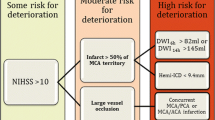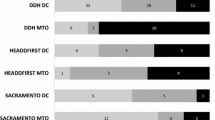Abstract
Neurosurgical involvement in the care of major stroke complications has yielded striking results in the subtentorial region but equivocal outcomes in the supratentorial compartment. Most neurosurgeons want to see some degree of deterioration before proceeding; thus, timing will be debated. Viewpoints have changed over the years regarding surgical or medical intervention, but in many patients the procedure has not produced a definitive change in outcome other than preventing death from terminal brainstem shift. The introduction of craniectomy (and craniotomy) to treat swollen ischemic brain or intracranial hemorrhage has historical interest.
Similar content being viewed by others
References
McKissock W, Richardson A, Walsh R. Spontaneous cerebellar hemorrhage. A study of 34 cases treated surgically. Brain. 1960;83:1–9.
Mendelow AD, Gregson BA, Fernandes HM, Murray GD, Teasdale GM, Hope DT, Karimi A, Shaw MD, Barer DH. investigators S. Early surgery versus initial conservative treatment in patients with spontaneous supratentorial intracerebral haematomas in the International Surgical Trial in Intracerebral Haemorrhage (STICH): a randomized trial. Lancet. 2005;365:387–97.
Mendelow AD, Gregson BA, Rowan EN, Murray GD, Gholkar A, Mitchell PM, Investigators SI. Early surgery versus initial conservative treatment in patients with spontaneous supratentorial lobar intracerebral hematomas (STICH II): a randomized trial. Lancet. 2013;382:397–408.
Hillairet JB. De l’hemorrhagie cerebelleuse. Arch Gen de Med. 1858;11:411–32.
Ballance H. A case of traumatic hemorrhage into the left lateral lobe of the cerebellum treated by operation with recovery. Surg Gynecol Obstet. 1906;3:223–5.
Stewart TG, Holmes G. Symptomatology of cerebellar tumors. A study of forty cases. Brain. 1904;27:522–49.
Fairburn B, Oliver LC. Cerebellar softening; a surgical emergency. Br Med J. 1956;1:1335–6.
Scarcella G. Encephalomalacia simulating the clinical and radiological aspects of brain tumor; a report of 6 cases. J Neurosurg. 1956;13:278–92.
Walker AE, Black P. The heroic treatment of acute head injuries: a critical analysis of the results. Am Surg. 1960;26:184–8.
Clark K, Nash TM, Hutchison GC. The failure of circumferential craniotomy in acute traumatic cerebral swelling. J Neurosurg. 1968;29:367–71.
Greenwood J Jr. Acute brain infarctions with high intracranial pressure: surgical indications. Johns Hopkins Med J. 1968;122:254–60.
Ivamoto HS, Numoto M, Donaghy RM. Surgical decompression for cerebral and cerebellar infarcts. Stroke. 1974;5:365–70.
Rengachary SS, Batnitzky S, Morantz RA, Arjunan K, Jeffries B. Hemicraniectomy for acute massive cerebral infarction. Neurosurgery. 1981;8:321–8.
Gillett G. Whose best interests? Advance directives and clinical discretion. J Law Med. 2009;16:751–8.
Li Y, Yang R, Li Z, Yang Y, Tian B, Zhang X, Wang B, Lu D, Guo S, Man M, et al. Surgical evacuation of spontaneous supratentorial lobar intracerebral hemorrhage: comparison of safety and efficacy of stereotactic aspiration, endoscopic surgery, and craniotomy. World Neurosurg. 2017;105:332–40.
Hanley DF, Thompson RE, Muschelli J, Rosenblum M, McBee N, Lane K, Bistran-Hall AJ, Mayo SW, Keyl P, Gandhi D, et al. Safety and efficacy of minimally invasive surgery plus alteplase in intracerebral haemorrhage evacuation (MISTIE): a randomised, controlled, open-label, phase 2 trial. Lancet Neurol. 2016;15:1228–37.
Author information
Authors and Affiliations
Corresponding author
Rights and permissions
Springer Nature or its licensor (e.g. a society or other partner) holds exclusive rights to this article under a publishing agreement with the author(s) or other rightsholder(s); author self-archiving of the accepted manuscript version of this article is solely governed by the terms of such publishing agreement and applicable law.
About this article
Cite this article
Wijdicks, E.F.M. Stroke and Craniectomy. Neurocrit Care 30, 235–238 (2019). https://doi.org/10.1007/s12028-017-0498-0
Published:
Issue Date:
DOI: https://doi.org/10.1007/s12028-017-0498-0






